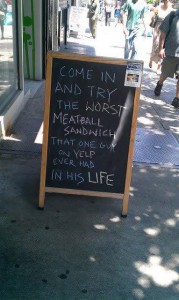
Those brands that are still ‘just’ advertising have it relatively easy. They partner with advertising agencies that are tasked with coming up with the creative idea for advertising campaigns. In fact, they have a dedicated staff of “creatives” tasked with doing just that.
Not to denigrate agencies, or creatives, or the vast amount of strategy, research, iterations, testing and refinements that go into creating advertising campaigns, but that model is now radically changing, making the question of where creative comes from a legitimate one.
Sure, advertising agencies own advertising. However in an increasingly mobile world where user-generated content, social media and earned media are burgeoning, advertising is a somewhat diminishing channel and not at all the core creative idea it once was. In digital (and soon, in traditional media as well), paid, earned and owned media are converging and commingling. Advertising is no longer a stand-alone. It works much, much more effectively in conjunction with broader strategic marketing initiatives that place as much (if not more) emphasis on owned and earned channels.
This raises a chicken-and-egg dilemma for marketers: who’s driving? If paid, earned and owned media all inform a campaign or marketing initiative, and learnings from one channel can be applied to the other for optimization and improvement, which channel leads, and which follow? It the channel that’s doing the driving isn’t advertising, it’s doubtful the creative core of a campaign comes from…creatives.
Together with my colleagues Jeremiah Owyang and Jessica Groopman, I’ve been working on research that looks at how paid, earned and owned media are converging. A growing trend is unquestionably that the creative germ originates in owned and earned media before it becomes paid (i.e. advertising).
Take Facebook ads that ‘pin’ a brand’s wall post in a display ad unit. Or Bazaarvoice’s new ads that retarget shoppers with ad units that feature a geo- and demographically targeted user review of the product they were just viewing.
 Brands can even turn lemons into lemonade by taking negative consumer reviews and, by adding a twist of clever content marketing, turn them into positives, as did one local eatery and Austin’s Alamo Drafthouse Cinema.
Brands can even turn lemons into lemonade by taking negative consumer reviews and, by adding a twist of clever content marketing, turn them into positives, as did one local eatery and Austin’s Alamo Drafthouse Cinema.
When marketing creative flows in from multiple sources, the way marketing and advertising work must inevitably shift. How? We’re sifting through findings, but there are some clear initial insights.
Real time: There’s a constant flow of consumers providing insight, feedback, media, and other digital material in real time on the web. Monitoring all this is a given, but reacting to it in real time is increasingly important, and something too few marketing organizations are prioritizing. Small wonder; real time marketing is resource intensive, and it’s hard. Increasingly, it’s necessary and will prove a real advantage to those who do it.
Listening and analysis: If creative ideas flow from chatter on the web, it’s critical to intelligently listen to all that chatter, to monitor it, triage it, and leverage it into ads and other marketing collateral. The SMMS sector is a veritable explosion of M&A activity right now due to this trend.
Content strategy: Owned media matters. Consumers expect it, social media demands it (and all brands are social, whether they’re playing in that particular sandbox or not). The web in general, and social media in particular, demands a steady stream of content, something brands must prepare for strategically as well as tactically.
Shifting agency models: It’s not as if advertising agencies haven’t seen this coming. Many are shifting staffing (as should brands) to bolster core capabilities such as creative and media with more support for content, data, and social media capabilities. PR shops are doing this a well, of course, and so are the more forward-looking brands.
Others will certainly follow. Because agencies creatives now only sometimes lead the creative charge, and the media plan is hardly what determines where, and how, that creative message spreads.
